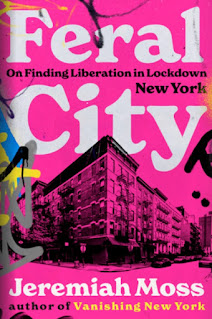The graffiti wall on Houston is scheduled to undergo another change, from the
Os Gemeos mural to something from
Shepard Fairey. (He's also
looking for more wall space.)
While we're enjoying these murals, it's important to keep in mind their hidden subtext--how they are, in fact,
a cog in the wheel of the Big Machine that is turning the Bowery into a luxury lifestyle destination.
 2008, from Super Touch
2008, from Super TouchLong an open canvas for graffiti artists, the celebratedly sanctioned muraling of the Wall began in 2008 when
Deitch Projects recreated Keith Haring's work from the 1980s, one that Jeffrey Deitch called, "
a fabulously renegade piece of New York City public street art."
As Deitch told the
New York Sun, "At the time, the corner of Houston and Bowery was the center of the downtown art world, because the galleries were in SoHo and the artists were in the East Village. 1982 was the peak of this downtown art world culture, and it's also when it started going mainstream. This project is a celebration of the dynamism of this time."
 Original mural, 1982 photo by Tseng Kwong Chi
Original mural, 1982 photo by Tseng Kwong ChiThe dynamism of
renegade street art going mainstream is one that gets many people riled up.
Mr. Brainwash gets labeled a FAKE and covered up by street artists.
D*Face stops defacing and moves into a gallery. Shepard Fairey designs an
ad campaign for Saks. The Cooper Square Hotel
adds "graffiti" to its wall.
Sometimes, walking the streets, it's hard to tell if you're looking at gallery art, graffiti, or advertising.
Questions about authenticity, reality, and intention arise. As for the Houston wall, it is playing a transformative role in the Bowery's conversion from Skid Row to intentionally created "art district" to high-end consumer playground--a replay of the Soho Model.
And it just happens that
the man who created the Soho Model is also the owner of the Wall.
 1983, photo by Martha Cooper
1983, photo by Martha CooperSince perhaps as early as 1984, the Houston wall has
belonged to a real estate company called Goldman Properties. Developer of luxury condos and hotels, art philanthropist Tony Goldman donates the wall space for the Deitch murals.
Writes
Ocean Drive magazine, "'Visionary' is the word most often used to describe Tony Goldman by those who have worked with him during his 40 years of rejuvenating neighborhoods. '
Tony will take the most barren, uninteresting space and infuse it with a vitality that you just didn’t think was possible.'"
Goldman is credited as a creator of liveable neighborhoods.
Haute Living has called him "
the founder of New York’s Soho... He was a pioneer into the area, snatching up properties as quickly as he could...renovating and turning them into lofts, the living style of the future."
Here's the Goldman
guide to Neighborhood Building 101. Simply put: "
Control the street life" and "effectuate what the vibe is going to be."
 1990: photo by VerplanckThe New York Times
1990: photo by VerplanckThe New York Times this week featured Goldman and his move into Miami's Wynwood neighborhood, which appealed to him because, he said, “
It had an urban grit that was ready to be discovered and articulated.”
The Wynwood street artists who came before Goldman aren't entirely happy about the project. Wrote
The Biscayne Times, "The murals at 'Wynwood Walls' are not graffiti. They are paintings, and Goldman has hired 24-hour security to make sure no one defaces them. As [artist] BooksIIII points out: '
Look, they’ve got tended grass and lighting and whatnot. Our stuff is still unpoliced; It’s just out there on the street.'"
Wynwood has also been known as
"Little San Juan" since the 1950s, and Goldman, according to the
New York Times, believes the Puerto Rican population there won't be displaced by his plans. But we all know how Soho-ification goes.
 2006 photo, OtherThings
2006 photo, OtherThingsFor years, until Goldman and Deitch's Haring recreation, the Wall was, as
Luna Park says, "a highly contentious graf spot." Often (but not always) illegally, they painted over each other without the interference or direction of mastermind gentrificationists or urban Svengalis.
It was, by and large, an organic thing. It just happened--unlike hyper-gentrification, which doesn't just happen, but is carefully plotted, orchestrated by the powerful and the patient.
 2006, legal Jace mural, from Razor Apple
2006, legal Jace mural, from Razor AppleThe Fairey show signals the end to Deitch Projects and I wonder what will happen to this wall, once it has outworn its use. Will it be sold? Torn down? Or
will it be permitted to fall back into the hands of renegades?If there are any left in the neighborhood.
 2007, legal OMNI, from Super TouchMore NYC street art
2007, legal OMNI, from Super TouchMore NYC street art:
Stolen LegosThe DecapitatorBloody PayphoneD*Face PaintsIndustrial ArtMom & PopismRevs/Cost Vanishing

























































